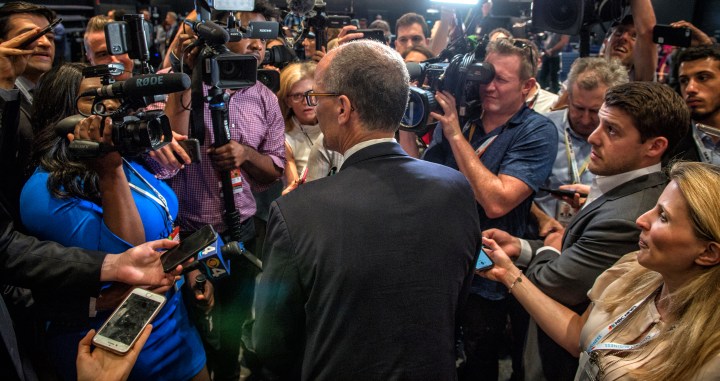US ELECTIONS 2020
Debates kick off as a crowded field of Democrat wannabes shout, ‘Pick me! Pick me!’

Readers might be forgiven for forgetting the US presidential election has begun, what with a US trade conflict with China; the love-hate relationship between the US and North Korea; chaos and terrible things along the US-Mexico border; and the rising tension between the US and Iran. There is a common thread in all this, and it is the lurching, incoherent Trump administration that partially explains why so many Democrats want to send him on his way and replace him.
By the time you read this on the morning of Thursday 27 June, the first of two 10-person debates among the declared candidates for the Democratic Party’s nomination for the 2020 presidential election will be history and 10 more candidates will be lining up for the second of these televised events on Thursday evening, US time.
Twenty declared candidates – and there are four more who didn’t quite make the cut-off for inclusion in those two debates by virtue of failing to raise sufficient donations so far, failing to register in the early polling data or both. These also-rans include some actual, already elected politicians in various districts, including an actual Democratic governor from a state, Montana, that often sees being an elected Democrat as something akin to participating in original sin.
The debates will be available on NBC, MSNBC and Telemundo at 9 pm Eastern Daylight Savings Time on both nights, and they will also be available to stream for free on NBCNews.com, MSNBC.com, and the NBC News app, as well as all Telemundo digital platforms.
On the first night, Massachusetts Senator Elizabeth Warren, former congressman Beto O’Rourke, New Jersey Senator Cory Booker, Minnesota Senator Amy Klobuchar, Washington Governor Jay Inslee, former Housing and Urban Development Secretary Julián Castro, Hawaii Congresswoman Tulsi Gabbard, New York City Mayor Bill de Blasio, Ohio Congressman Tim Ryan and former Maryland congressman John Delaney will appear together.
Then, on the second night, former vice-president Joe Biden will take the stage alongside Vermont Senator Bernie Sanders, California Senator Kamala Harris, South Bend, Indiana mayor Pete Buttigieg, New York Senator Kirsten Gillibrand, Colorado Senator Michael Bennet, former Colorado governor John Hickenlooper, California Congressman Eric Swalwell, entrepreneur Andrew Yang, and self-help author Marianne Williamson.
Four other candidates — Montana Governor Steve Bullock, Massachusetts Congressman Seth Moulton, Miramar, Florida mayor Wayne Messam, and former Alaska senator Mike Gravel — failed to meet minimum criteria and won’t be appearing on either stage.
While President Donald Trump will obviously not be a party to these two nights of intra-party discussion, he clearly intends to prowl basilisk-like from the margins, issuing a torrent of the semi-literate, stream of consciousness tweets – or via some other distraction.
The basic framework for determining who participates was set out by the Democratic National Committee which initially set a limit of 20 candidates and required that to be included they either had to be polling at 1% or more in three separate polls from a pre-approved list, or by raising money from at least 65,000 unique donors. The top tier, defined as those at 2% or more, were split among the two debates. Once the lottery had been conducted and the two groups had been formed, NBC decided to put the lineup with Biden, the frontrunner, on the second night to “maximise viewership”.
The potential ungainliness (or real opportunity) of the ensuing conversations stems from the enormous diversity and number of these would-be presidents. Among the 20, the field is racially black and white as well as Hispanic American. The candidates are male and female, youthful and very much older (including one, Joe Biden, who was first elected to public office before the youngest, Pete Buttigieg, was even born). There are those effectively running on just one key issue – as with Washington state Governor Jay Inslee and his focus on climate change – or those focused on many – as with Elizabeth Warren who has launched a position paper on virtually every topic in the public space.
Still, as David Axelrod, the longtime Democratic Party campaign organiser and strategist, noted on one of the political talk shows the other day, every one of these hopefuls will be trying – even if nothing else – to complete successfully the statement for viewers and journalists:
“I can beat the pants off Donald Trump, come November 2020, because…”
Yes, demonstrating poise, equanimity under attack, vigour, strength, resolve, imaginativeness, knowledgeability, likeability, and uniqueness will also be important – as well as successfully differentiating themselves from the bigger herd. But for the party as a whole what will be crucial coming out of this beauty contest (or rowdy cattle auction) must be avoiding the savagery of what the Republicans achieved in 2016 – the so-called circular firing squad that eventually destroyed the chances of every serious, experienced politician, saddling them instead with Trump as their standard-bearer.
As Brookings Institution scholar John Hudaashes recently noted:
“With fewer than 500 days left until the 2020 election, the Democrats will participate in their first round of primary debates starting tonight. Over the course of two nights, 20 Democrats will take the stage to face off against each other, against the candidates participating in the debate on an opposite night, and against the president. This marks a true opening salvo for the 2020 presidential campaign that provides insight into the candidates’ abilities, as well as the tone and tenor of the race.
“…While some candidates like former vice-president Joe Biden, Massachusetts Senator Elizabeth Warren, and Vermont Senator Bernie Sanders are well-known figures, most of these candidates remain anonymous to the American public. These debates will be the first chance candidates have to introduce themselves to a large audience.
“This campaign has presented some challenges for the Democratic National Committee. After allegations of favoritism in the 2016 race, the new chairman of the Democratic Party, Tom Perez, has gone out of his way to demonstrate fairness and parity. The size of the field has made the management of a debate unwieldy, forcing the party to use two debates over two nights.
“Split debates are not unprecedented, as Republicans utilised the same model in 2016… The Republican model packed all of the leading candidates onto one stage and left those polling lowest on a secondary stage. The result was a ‘front runners’ debate and a ‘children’s table’ of sorts, which helped institutionalise a lack of attention to lower-polling candidates.”
But the Democratic National Committee’s process was designed to get around those concerns. The traditional fish fry speech party over the weekend a few days before the debates, hosted by South Carolina Democratic Congressman Jim Clyburn, featured most of these candidates joining in for a relatively good-humoured gathering, each making their “Pick me! Pick me!” pitches to the attendees. South Carolina’s pre-debate prominence mattered for several reasons.
First of all, the South Carolina primary comes early in the 2020 primary cycle and its results could have an outsized impact on all the other primary polls to follow, especially if a candidate begins to demonstrate real momentum. Second, the percentage of African Americans in the South Carolina Democratic Party’s electorate is significantly higher than in most other states, and so the ability of white candidates to generate enthusiasm among African Americans gets a test early in this primary.
Further, the manner in which both white and black candidates end up squaring off against one another in this primary may be predictive of how the Democratic Party’s coalition (with a significant share of its supporters coming from among the nation’s minority communities) holds together effectively or not, right up to the election itself next year in November.
As things have been trending in the polling, former vice-president Joe Biden holds a significant lead in support, followed by Vermont Senator Bernie Sanders and Massachusetts Senator Elizabeth Warren. Behind those three but next, in a surprise showing, is South Bend, Indiana mayor Pete Buttigieg.
Thereafter, the support levels dribble off into single digits. But again, this is still very early and most voters nationally are almost certainly still unable to name all the declared candidates – let alone identify their key campaign issues, their prior experience, or where they might fall on any familiar left/right liberal/conservative continuum. As a result, these debates may begin to help voters understand the candidates better. Some surveys have said that up to 75% of voters plan to watch some or all of the debates, although that seems a rather high bar this early in the campaign.
The real problem is that these two programmes are not really debates at all in the way we were taught about political debates in high school history classes, as in the mould of the 1858 Lincoln-Douglas and 1960 Kennedy-Nixon verbal matches. This time around, the two nights are more like a beauty contest but with clever, quick verbal retorts – and with no bathing costumes or talent competitions. And the candidates saying they also crave “world peace” will not cut it. In fact, there will not be opening statements as they have usually been done in other, earlier debates, and the moderators (and effectively ringmasters) are supposed to keep things moving right along.
As Ashley Parker wrote in The Washington Post on 26 June:
“The trick for the Democrats, as with their Republican predecessors, is to find a way to capture attention and break away from the pack. Trump didn’t necessarily win the debates themselves four years ago, but he always won the show — and, with it, the White House.
“‘I tell people these are not debates,’ said former Arkansas governor Mike Huckabee, who ended his presidential run in February 2016. ‘I was a debater in high school and college, and these are not debates. These are television shows.’
“Trump, a former reality TV star, quickly realised that every circus needs a ringmaster and appointed himself to the role. … Texas Sen. Ted Cruz, one of Trump’s most vocal rivals in 2016, said moderators ‘are often looking for fireworks’ — a phenomenon he suspects Democrats will also encounter.”
Fireworks are not reasoned debate, but they do help drive up those audience numbers.
On this first night, Warren has an opportunity to drive up her supporter numbers and thus begin closing the gap between Sanders and Biden and herself. But she also faces the possibility she will be unable to break away from the other nine would-be candidates appearing with her, and that her moments with the cameras on her end up leaving viewers bewildered by her welter of policies and plans, rather than with a better sense of her inner core.
The Thursday night debate features Biden and Sanders as well as Buttigieg, along with seven others. The challenge for Biden is to avoid any more unforced errors (or comments that seem to many as errors) beyond the ones he seems to have done already as with that awkward embrace of two long-dead Southern segregationist senators, and to project a sense of inevitability, electability, and presidentialness, as well as a sense of purpose and resolve, but above all, some real fire, given his age.
Sanders has to make his best case for his patented form of radical economic transformation, but without sounding like an old-style class scold – especially since that version left him several million primary votes short the last time against Hillary Clinton and as that turf is now also being occupied by other, younger figures.
Still, the campaign season is early and a candidate can still recover from a weak or flat performance. But, to remain at least theoretically viable, they must avoid committing the kinds of gaffes that label them as “definitely not the one”– and they must also articulate an answer to David Axelrod’s question of “Why me?” in a way that makes viewers start to think, “Well, why not?” DM



















 Become an Insider
Become an Insider